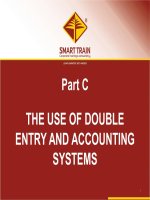BÀI GIẢNG kế TOÁN QUỐC tế chapter 1 introduction to accounting
Bạn đang xem bản rút gọn của tài liệu. Xem và tải ngay bản đầy đủ của tài liệu tại đây (557.15 KB, 15 trang )
Part A
THE CONTEXT AND PURPOSE
OF FINANCIAL REPORTING
1
Part A
Chapter 1: Introduction to accounting
Chapter 2: The regulatory framework
2
Chapter 1
INTRODUCTION TO
ACCOUNTING
Learning Objectives
1.
The purpose of financial reporting
2.
Types of business entity
3.
Users
4.
The main financial statements
4
The purpose of financial reporting
A business has a number of functions, the most prominent is to make a profit for the owners.
Profit is the excess of
income over expenditure
5
Types of business entity
•
Sole traders – refers to ownership, sole traders can have employees.
•
Partnerships – two or more people working together to earn profits.
•
Limited liability company
– owners have liability limited to the amount
they pay for their shares.
– a limited liability company has a separate
legal identity from its owner.
6
Users
Users of accounts
•
•
•
•
•
•
•
•
•
Managers of the company
Shareholders of the company
Trade contacts
Providers of finance to the
company
Taxation authorities
Employees of the company
Financial analysts and advisors
Government and their
agencies
The public
The larger the entity,
the greater the
interest from various
groups of people.
7
The main financial statements
Entity concept
Asset
The entity is treated as
separate from its
owners
•The entity owns the
cash invested
•The entity owes this
cash to the owner
(capital)
Something valuable
which an entity owns or
has use of
• A factory or warehouse
• Inventories for resale
• Cash
Liability
Something owed to
somebody else
• Bank loan
• Amounts owed to
suppliers
• Taxation owed to
government
8
The statement of financial position
•
Is a list of assets, liabilities and capital of a business at a given moment.
•
Under IAS 1 (revised), the balance sheet is now known as the statement of financial position.
9
The statement of financial position
10
The statement of financial position
Capital + liabilities = assets
11
Main financial statements
Statement of financial position
A list of assets owned by the entity and
liabilities owed by the entity on a
particular date.
• Total assets = Total liabilities
• Amount invested by owner is capital
Income statement
A record of income generated and
expenditure incurred over a given
period
12
Main financial statements
The financial statements are prepared on an accruals basis
Accruals concept
A sale or purchase is dealt with in the period it is made,
even if cash changes hands later than this.
Non-financial statements may be required under local legislation.
13
The income statement
•
Matches revenue earned in a period with the costs incurred in earning it.
14
The income statement
Gross profit =
sales – cost of sales
Net profit =
gross profit – expenses
15









